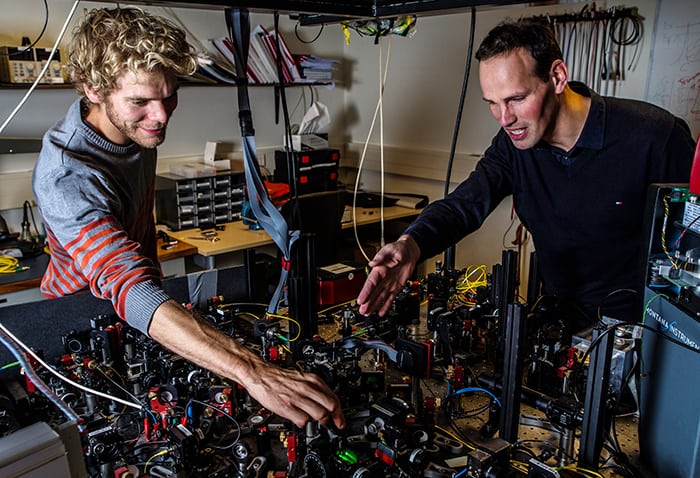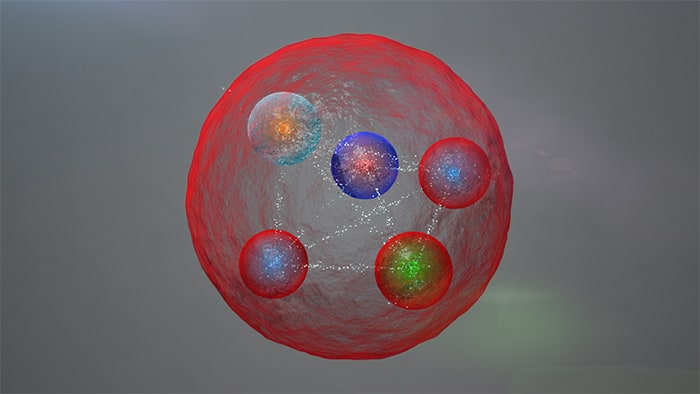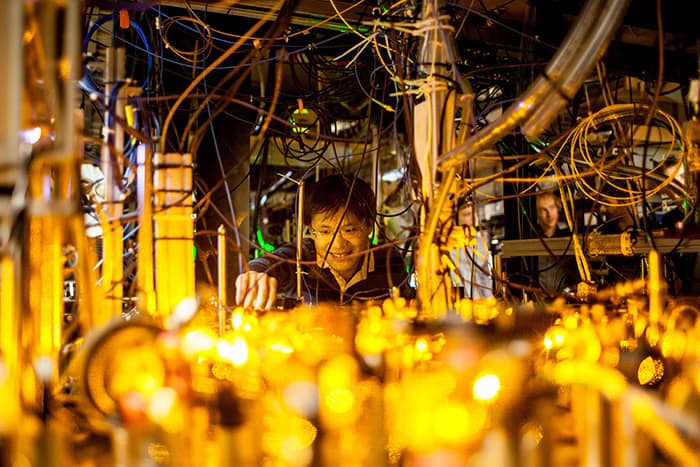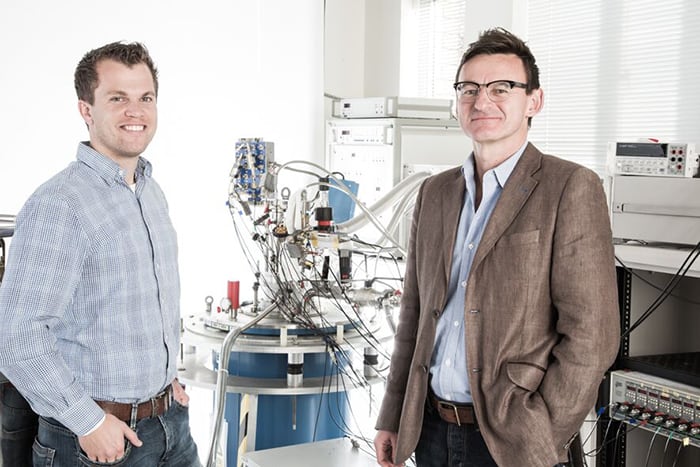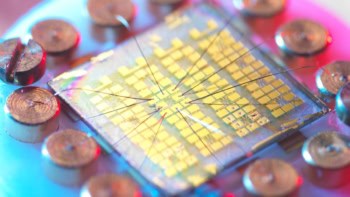The Physics World 2015 Breakthrough of the Year goes to Jian-Wei Pan and Chaoyang Lu of the University of Science and Technology of China in Hefei, for being the first to achieve the simultaneous quantum teleportation of two inherent properties of a fundamental particle – the photon. Nine other achievements are highly commended and cover topics ranging from astronomy to medical physics
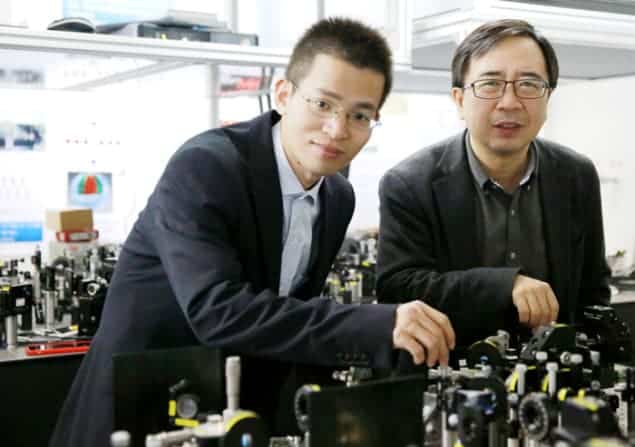
Synonymous with the fictional world of Star Trek, the idea of teleportation has intrigued scientists and the public alike. Reality caught up with fiction in 1993, when an international group of physicists proved theoretically that the teleportation of a quantum state is entirely possible, so long as the original state being copied is destroyed. Successfully teleporting a quantum state therefore involves making a precise measurement of a system, transmitting the information to a distant location and then reconstructing a flawless copy of the original state. As the “no cloning” theorem of quantum mechanics does not allow for a perfect copy of a quantum state to be made, it must be completely transferred from one particle onto another, such that the first particle is no longer in that state.
Complete and perfect
In other words, a complete and perfect transfer is completed when the first particle loses all of the properties that are teleported to the other. The first experimental teleportation of the spin of a photon was achieved in 1997, and since then, everything from individual states of atomic spins, coherent light fields and other entities have been transferred. But all of these experiments were limited to teleporting a single property, and scaling that up to even two properties has proved a herculean feat.
Pan and Lu’s team has now simultaneously transferred a photon’s spin (polarization) and its orbital angular momentum (OAM) to another photon some distance away. Teleportation experiments usually require a “quantum channel” via which the transfer actually takes place. This channel is normally an extra set of “entangled” photons with quantum states that are inextricably linked so that any change made to one instantly influences the other. In this experiment, this is a “hyper-entangled” set, where the two particles are simultaneously entangled in both their spin and their OAM (see “Two quantum properties teleported together for first time”).
Although it is possible to extend Pan’s method to teleport more than two properties simultaneously, this becomes increasingly difficult with each added property – the likely limit is three. To do this would require the ability to experimentally control 10 photons, while the current record is eight. The team is currently working hard to change that though, and Pan says that they “hope to reach 10-photon entanglement in a few months”. An alternate method that is also being developed could allow the team to double that figure to 20 within three years. “We should be able to teleport three degrees of freedom of a single photon or multiple photons soon,” he adds.
The ability to teleport multiple states simultaneously is essential to fully describe a quantum particle, and is a tentative step towards teleporting anything larger than a quantum particle. Pan adds that “quantum teleportation has been recognized as a key element in the ongoing development of long-distance quantum communications that provide unbreakable security, ultrafast quantum computers and quantum networks”.
• Watch our Google+ Hangout, where physicsworld.com editor Hamish Johnston talks with Pan and Lu about all things quantum
The top 10 were chosen by a panel of six Physics World editors and reporters, and the criteria for judging the top-10 breakthroughs included
- fundamental importance of research;
- significant advance in knowledge;
- strong connection between theory and experiment; and
- general interest to all physicists.
Now for our nine runner-up breakthroughs, which are listed below in no particular order.
Cyclotron radiation from a single electron is measured for the first time
To the Project 8 collaboration, for measuring the cyclotron radiation from individual electrons emitted during the beta decay of krypton-83. This radiation is emitted as the electron passes through a magnetic field, and allows the team to make a very precise measurement of the energy at which the particle is emitted. Project 8 is now working hard to improve the precision of the measurement so it can be used to calculate one of the most elusive quantities in physics – the mass of the electron antineutrino that is also given off during the beta decay.
Weyl fermions are spotted at long last
To Zahid Hasan of Princeton University, Marin Soljačić of MIT, and Zhong Fang and Hongming Weng of the Chinese Academy of Sciences, for their pioneering work on Weyl fermions. These massless particles were predicted by the German mathematician Hermann Weyl in 1929. Working independently, a team led by Hasan, and another led by Fang and Weng, spotted telltale evidence for quasiparticles that behave as Weyl fermions in the semimetal tantalum arsenide. Soljačić and colleagues have spotted evidence for Weyl fermions in a very different material – a “double-gyroid” photonic crystal. The massless nature of Weyl fermions means that they could be used in high-speed electronics; and because they are topologically protected from scattering, they could be useful in quantum computers.
Physicists claim ‘loophole-free’ Bell-violation experiment
To Bas Hensen, Ronald Hanson and colleagues of the Delft University of Technology, for making a measurement of Bell’s inequality that is simultaneously free from both the locality and detection loopholes. Their experiment involved entangling spins in diamonds separated by 1.28 km and then measuring correlations between the spins. The large separation between the diamonds and the relative ease with which the spins can be measured ensured that the experiment is loop-hole free – and its result confirmed the existence of the seemingly bizarre concept of quantum-mechanical entanglement.
First visible light detected directly from an exoplanet
To Jorge Martins of the Institute of Astrophysics and Space Sciences and the University of Porto and colleagues in Portugal, France, Switzerland and Chile, for being the first to measure a high-resolution optical spectral signature of light reflected from an exoplanet. The team used the High Accuracy Radial velocity Planet Searcher instrument at the European Southern Observatory’s La Silla Observatory to study light from 51 Pegasi b – which was first spotted in 1995. Using a new technique that they developed, Martins and colleagues were able to measure the planet’s mass, orbital inclination and reflectivity, which can be used to infer the composition of both the planet’s surface and atmosphere.
LHCb claims discovery of two pentaquarks
To the LHCb collaboration at CERN, for showing that five quarks can be bound together in particles called pentaquarks. First predicted in the 1970s and the subject of controversy in the 2000s, the existence of pentaquarks was resolved this year when two pentaquarks with masses around 4400 MeV/c2 emerged from proton collisions at the LHC. Both signals had statistical significances greater than 9σ – much higher than 5σ, which is the golden standard for a discovery in particle physics.
Hydrogen sulphide is warmest ever superconductor at 203 K
To Mikhail Eremets and colleagues at the Max Planck Institute for Chemistry and the Johannes Gutenberg University – both in Mainz, Germany – for discovering the first material that is a superconductor at a temperature that can occur naturally on the surface of the Earth. The team found that hydrogen sulphide under an extreme pressure of 1.5 million atmospheres is a superconductor up to a temperature of 203 K, which is 19 K warmer than the coldest temperature ever recorded in Antarctica. While further research is needed to understand why superconductivity arises in this material, the discovery could pave the way to the holy grail of superconductors: a material that superconducts at room temperature.
Portable ‘battlefield MRI’ comes out of the lab
To Michelle Espy and colleagues at the Los Alamos National Laboratory in the US, for creating a practical, portable ultralow-field magnetic resonance imaging (MRI) system. Unlike conventional MRI systems that use superconducting coils to create very high magnetic fields, the new system relies on much-weaker fields that are much easier to create in remote locations. This, however, means that the system must be capable of detecting much-weaker signals, which it does using superconducting quantum interference devices (SQUIDs). With its low power requirements and lightweight construction, the team hopes that its prototype design can soon be deployed for use in medical centres in developing countries, as well as in military field hospitals.
Fermionic microscope sees first light
To Lawrence Cheuk, Martin Zwierlein and colleagues at MIT, for building the first “fermionic microscope” – a device that is capable of imaging up to 1000 individual atoms in an ultracold gas. Great strides have been made in understanding how electrons interact with each other in materials. This has been done by cooling fermionic atoms to ultracold temperatures, and then using light and magnetic fields to fine-tune the interactions between the atoms. The fermionic microscope takes this approach one important step further by allowing physicists to observe the behaviour of individual fermions as the gas cools. The new technique could soon be used by researchers to observe magnetic interactions between atoms, and could even be used to detect quantum entanglement within the ensemble.
Silicon quantum logic gate is a first
To Andrew Dzurak, Menno Veldhorst and colleagues at the University of New South Wales in Australia and Keio University in Japan, for creating the first quantum-logic device made from silicon. Their controlled-not (CNOT) gate is a fundamental component of a quantum computer and was made using conventional semiconductor manufacturing processes. The device uses electron spin to store quantum information, and the researchers now plan to scale up the technology to create a full-scale quantum-computer chip.

